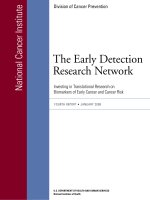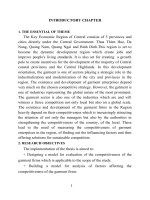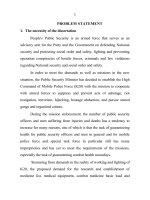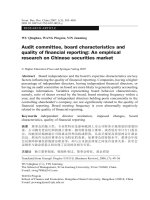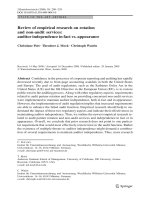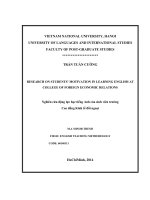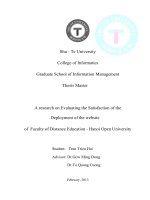RESEARCH ON BUILDING OF “GREEN SCHOOL”
Bạn đang xem bản rút gọn của tài liệu. Xem và tải ngay bản đầy đủ của tài liệu tại đây (530.34 KB, 70 trang )
THAI NGUYEN UNIVERSITY
THAI NGUYEN UNIVERSITY OF AGRICULTURE AND FORESTRY
TONG THI HONG
RESEARCH ON BUILDING OF “GREEN SCHOOL”
IN DOI CAN PRIMARY SCHOOL THAI NGUYEN PROVINCE
BACHELOR THESIS
Study mode: Full-time
Major: Environmental Sicience and Management
Faculty: International Traning and Development Center
Batch: 2010-2015
Thai nguyen, 20/01/2015
THAI NGUYEN UNIVERSITY
THAI NGUYEN UNIVERSITY OF AGRICULTURE AND FORESTRY
ADVANCED EDUCATION PROGRAM
BACHELOR THESIS
RESEARCH ON BUILDING OF “GREEN SCHOOL”
IN DOI CAN PRIMARY SCHOOL THAI NGUYEN PROVINCE
Student Name
Student ID
Year
Supervisors
: Tong Thi Hong
: DTN1053110294
: 2010 – 2015
: Assoc. Prof Do Thi Lan
: Msc Truong Thi Anh Tuyet
JANUARY - 2015
I
Thai Nguyen University of Agriculture and Forestry
Degree Program
Bachelor of Science in Environmental Science and
Management
Student Name
Tong Thi Hong
Student ID
DTN1053110294
Thesis Title
Research on building of “Green School” in Doi Can Primary
School in Doi Can Primary School – Thai Nguyen Province
Supervisor
Assoc. Prof. Dr. Do Thi Lan, MA. Truong Thi Anh Tuyet
Abstract:
In recent years, environmental pollution is becoming worse. The education of
environmental protection is essential, especially for primary students. Primary school is
the first place for students to start learning and working. Therefore, the reasearcher
have studied the establishment of “Green Schools” model in Doi Can Primary Schools.
The aim of the study is to assess the education as well as measures to protect the
environment so that students and teachers can study and work in a safe and clean
environment. In addition, this enables students to enhance their knowledge, awareness
and responsibility for the environment. The study conducted a survey of incidental 30
students and 25 teachers about environmental awareness. Analyzing eight criteria of
“Green schools”, we considered it as the basis of evaluating the current state of the
school. The results revealed that the facilities and environmental awareness of students
and teachers are satisfactory, 90%, 92% respectively. The measures added into
extracurricular activities such as: Clubs, Travel, Games, Arts and culture, etc. have
increased the effectiveness of the course as well as students’ perception of
environmental protection. “Green Schools” is a beneficial model, which is not only a
green, safe and clean school but also a place to environmentally educate students from
early age.
Keywords:
Environmental pollution, Green Schools, Extracurricular
activities, Doi Can Primary School, Environment protection.
Number of Pages:
Date of Submission:
47 pages
January 15, 2015
II
ACKNOWLEDGEMENT
First and foremost, I wish to express my sincere thanks to the boards of to teachers
in faculty of International Training and Development as well as teachers in Thai
Nguyen University of Agriculture and Forestry for providing me all the necessary
facilities to complete this research.
In particular, I would like to thank my supervisors Assoc. Prof. Dr Do Thi Lan,
Dean of Faculty Environmental Resources, and MA. Truong Thi Anh Tuyet who
guided me wholeheartedly during the implementation of this research project. I
place on record, my sincere gratitude to all staffs, government and people in Doi
Can Primary School - Thai Nguyen province for their expert, valuable guidance and
generous support to our project. Finally yet importantly, I take this opportunity to
express our deepest appreciation to our families, relatives, friends and fellow
students in class of K42-Advanced Education Program who encouraged and
supported me unceasingly and all who, directly or indirectly, have lent their helping
hand in this venture.
I sincerely thank you!
III
TABLE OF CONTENTS
CHAPTER I: INTRODUCTION .................................................................. 1
1.1.The rationale of project.......................... Error! Bookmark not defined.
1.2. Aims of the study .................................................................................... 2
1.3. Research questions and hypothesis......................................................... 2
1.3.1. Research questions............................................................................ 2
1.3.2. Hypothesis......................................................................................... 2
1.4. Limitations of the research...................................................................... 2
1.5. Definition of Terms................................................................................ 2
CHAPTER II: LITERATURE REVIEW .................................................... 4
2.1. Scientific basis ........................................................................................ 4
2.2 Factual basis............................................................................................. 5
2.2.1 Status of research on the Green School in the world......................... 5
2.2.2 Status of research on the Green School in Vietnam ........................ 10
CHAPTER III: MATERIALS AND METHODS...................................... 12
3.1. Subjects and research scope.................................................................. 12
3.2. Location and time.................................. Error! Bookmark not defined.
3.3. Methodology ......................................................................................... 12
3.3.1. Inherited method ............................................................................. 12
3.3.2. Interview and survey questionnaire method................................... 12
3.3.3. Analysis method which bases on criteria ....................................... 13
3.3.4. Assessment, synthesis, comparison method ................................... 15
CHAPTER IV: RESULT ............................................................................. 16
4.1. Basic situation and the current state of environmental education in Doi
Can primary school ...................................................................................... 16
4.1.1. Basic situation of Doi Can primary school..................................... 16
IV
4.1.2. Current status of environmental education in Doi Can primary
school according to each criteria .............................................................. 19
4.2. Overall assessment of environmental education in Doi Can Primary
school ........................................................................................................... 33
4.3. Proposal of "Green School" model in Doi Can Primary school........... 35
4.3.1. Building a green, clean, beautiful and safe school in Doi Can
Primary school .......................................................................................... 35
4.3.2. Building on some methods through extra-curricular activities ...... 38
4.3.3. Collaborating with students’parents in building a "green, clean,
beautiful and safe" school ......................................................................... 45
CHAPTER V: DISSCUSSION AND CONCLUSION .............................. 47
5.1 Discussions............................................................................................. 47
5.2 Conclusions............................................................................................ 47
REFERENCES .............................................................................................. 49
APPENDICES ............................................................................................... 51
V
LIST OF FIGURES
Figure 4.1 Location of Doi Can primary school .......................................................16
Figure 4.2 Drinking water system for students at Doi Can Primary School.............21
Figure 4.4. Drinking water system for students at Doi Can Primary School............23
Figure 4.3 Signs of prohibition of parking outside school gate ................................37
VI
LIST OF TABLES
Table 4.1. Achievement Report in 2013-2014.................................................17
Table 4.2. The quality of teachers in Doi Can primary school........................17
Table 4.3. Socialization projects for green, clean, beautiful and
friendly schools and classrooms 2008-2012 ..................................18
Table 4.4. Quantity of trees in Doi Can Primary School.................................19
Table 4.5. Current situation of restrooms in Doi Can Primary School: ..........24
Table 4.6. Survey results for creating classroom environment: ......................25
Table 4.7. Survey of environmental awareness of Doi Can Primary
School’s students:...........................................................................26
Table 4.8. Overall Assessment of environmental protection awareness
of students in Doi Can Primary School..........................................33
Table 4.9. Overall Assessment of environmental education of teachers
in Doi Can Primary School ............................................................34
1
PART I
INTRODUCTION
1.1.
Research rational
The environment is very important for human life. Each of us needs to have a
responsibility, and work together to build a cleaner habitat. Every day, the
environments that we are living are houses, and village and an important
environment that children grow up is the school.
The school is the second home of the students. In particular, Primary school is
the first place for the children to start learning and working. When students study in
school, they need to acquire the systematically scientific knowledge. On the one
hand, a good educational environment will help students to acquire the skills which
are necessary for the formation and development of the original qualities of human
beings in an environment. On the other hand, the educational environment plays
roles on the formation and development of personality through social relationships
in diverse academic life, and daily activities of the children.
It is true that everyone wants to live, learn and play in a real green, clean and
beautiful environment. The green, clean and beautiful school creates interesting
learning and activities environment which attract students, and make them more
beloved their school, teachers, and friends.
Doi Can Primary School which is located in the center of Thai Nguyen City.
Doi Can Primary School has always been achievements and it is the first position of
the education in Thai Nguyen. The movement of teaching and learning is extremely
good. Coming to Doi Can Primary School also is the unit which has a lot of diverse
activities such as sport, charitable, outdoor and health care activities.
To educate students rise awareness, habits, and environmental protection of
student and make them keen on go to school. Addition, they understand that every day
that they attend the class is a happy day. Moreover, formation of good character and
civilized lifestyle for young generation can be contributed from the Primary school.
2
From the idea above, the researcher aims to do a study on the: “Research on
the building of “Green School” in Doi Can Primary School – Thai Nguyen city”
under supervisor Assoc.Prof Do Thi Lan – Dean of Environmental Resources and
Truong Thi Anh Tuyet - Lecturer – Thai Nguyen University of Agriculture and
Forestry.
1.2. Research’s objective
- To evaluate of current status of environmental education in Doi Can
Primary School
- To propose “Green School” which educate students to improve their skills
such as knowledge and awareness of protecting the environment not only through
the landscape of the school but also through education daily lessons
1.3. Research questions and hypothesis
1.3.1. Research questions
+ What is the current status of environmental education in Doi Can
Primary School?
+ Which methods can be built to improve environmental education in Doi Can
Primary? How?
1.3.2. Hypothesis
+ The facility and current environmental education are very good.
+ Building on content of activities which apply in Extra-curricular activities
such as games, clubs and travel…to educate environmental education in Doi Can
Primary School.
1.4. Limitations
Due to the limit of economic conditions, as well as the limit of research time and
the ability to access data sources, the research only focuses on Doi Can Primary School.
1.5. Definitions
* According to Article 1 paragraph 3 of the Law on Vietnam Environmental
Protection (The National Assembly of Viet Nam, 2005), the environment is defined
as follows: "Environment includes natural and man-made material factors
3
surrounding human, influence to a productive life, the existence and development of
human beings and creatures."
* Environmental pollution
According to the World Health Organization: "Environmental pollution is the
transfer of energy or waste to environment which causes harming to human health,
development or degrading organisms or reducing environmental quality”.
* Soil pollution
“Soil pollution is a result of human activities altering the ecological factors
beyond the ecological limits of the living communities in the soil”. (Hoang Van
Hung, 2008).
* Water pollution
“Water pollution is a change for the worse of the physical, biological,
chemicals properties of the water, with the presence of foreign substances in liquid,
solid as the water becomes toxic for humans and animals, reducing biological
diversity in the water.” (Hoang Van Hung, 2008)
* Air pollution
Air pollution: "Air pollution is the presence of a foreign substance or an
significant change in the composition of the air making the air not clean or causing
unpleasant smell , reducing visibility (due to dust). (Hoang Van Hung, 2008)
* Environmental degradation
According to Article 3 paragraph 7 of the Law on Vietnam Environmental
Protection (The National Assembly of Viet Nam, 2005),”Environmental
degradation means qualitative and quantitative deterioration of environmental
components, adversely affecting human beings and organisms”.
* Environmental protection activities
According to Article 3 paragraph 3 of the Law on Vietnam Environmental
Protection (The National Assembly of Viet Nam, 2005) means activities of keeping
the environment sound, clean and beautiful; preventing and restricting adverse
impacts on the environment, responding to environmental incidents; remedying
environmental pollution and degradation, rehabilitating and improving the
4
environment; exploiting and rationally and economically using natural resources;
and protecting biodiversity.
* What is a Green School?
Cosbos's E & E Green School Community said that Green School is a school
Which use efficient energy and
sustainable financial. It also supports for
environmental management and the goals of students and demonstrates sustainable
environmental.
Council of Educational Facility Planners International (CEFPI) defines that
"A healthy school (which is replaced for green school) involves and cares welfare
of all participants. This is a school having a friendly environment, saving energy
and concerning in health of its members".
The Collaborative for High Performance Schools (CHPS) said that "A
high performance green school has three special contributions: The operation
cost in Green School is less than a traditional school; it is designed to improve
the learning environment and work; It conserves vital energy resources such as
energy and water.
PART II
LITERATURE REVIEW
2.1. Theoretical background
- Instruction 40/2008 / CT-BGDDT July 22nd 2008 the Ministry of Education
and Training launched about "Building friendly schools, positive students"
movement in the school stage 2008-2013.
- Planning No. 307 / Planning – BGDDT, July 22nd, 2008 by the Ministry of
Education and Training to deployment the; "Building friendly schools, positive
students" movement in the school, 2008 - 2009 and the period from 2008 to 2013.
- Official Letter No 1741 / BGDĐT - GDTrH about instruction results of build
“friendly schools and positive students” movement.
5
- Instruction No. 18/2008 / CT-PPC October 2nd, 2008 in the emulation:
"Building friendly schools, positive students".
- Decision 4458 / QD-BGDĐT August 22nd, 2007 of the Ministry of Education
and Training issued regulations about safety and injury prevention in schools.
- Joint Circular No. 18/2011 / TTLT-BGDĐT - BYT April 28, 2011 on
stipulating the contents of the medical work assessment in Primary schools, high
schools, secondary schools and schools which have many levels.
- Circular No. 67/2011 / TT-BGDĐT December 30th, 2011 the regulation of
evaluation criteria Primary school.
- Decision No. 32/2005 / QD BGDDT October 24th, 2005 recognizes the
regulations of national standards for Primary school.
- Environmental Protection Law has force from January 1st, 2015.
2.2 Empirical background
2.2.1 Status of research on the Green School in the world
Green School was conceived by its founders in 2006 following their exit from the
Jewelry Business. The school opened in September 2008 with 90 students and a
tailor made campus that had only recently emerged from the jungle and rice fields.
Since then it has grown physically and in student numbers.
Green School combines the talent of several and very differently gifted individuals.
Its founders, John and Cynthia Hardy, have been residents in Bali for more than 30
years and recognized a unique opportunity to create something truly inspiring and
outside of the structural, conceptual, and physical limitations of many traditional
schools. John Hardy, a Canadian art student who was as creative as he was intuitive,
made his way to Bali in 1975. Intrigued by the Balinese craft traditions, he settled
there and began producing jewellery with local artisans. Cynthia, an American who
would years later become his wife and business partner, arrived in Bali in 1982, as a
stopover on a round-the-world trip while she was considering attending law school
at Berkeley. She stayed in Bali and started a small jewellery business of her own,
which, owing to her talents in analysis and logistics, became successful in its own
6
right. This right-brain, left-brain pair was destined for one another, and in 1989,
their professional collaboration turned out to be magical. One of the keys to their
success is that they have done well by doing good. From the beginning, John and
Cynthia’s approach to business was about making jewellery while being respectful
to Bali’s land, its environment, its people and its culture. It became their mission to
share with others the educational benefits that they were fortunate enough to
provide their children, and Green School is the realization of that vision.( Greenest
school on Earth, (n.d). Green School History and Founders ).
The primary school course focuses on developing the whole child. Our integrated
and experiential lessons are designed around some of the latest educational
research. We aim to develop each child’s IQ, EQ and SQ through a variety of multisensory activities each day. Children are encouraged to be expressive and creative
through experiential lessons in the classroom and out. Our core academic standards
are derived from a variety of rigorous international sources. Science, mathematics,
and English are taught daily. In addition to this we offer our own Green School
subjects such as Global Awareness, Green Studies, performing and visual arts,
Indonesian Studies and Bahasa Indonesia. Our Grade 4 and 5 students also study
marimba as an integral part of their performing arts program.
All of the core subjects are introduced in the thematic approach. The essential skills
from these subjects are then explicitly taught during the daily proficiency lessons in
mathematics and English. Students will be working on individual learning
programs in mathematics and English across all grades. This approach enables all of
the students to grow and thrive confidently in and a safe and supportive
environment. The thematic lessons are driven by student interest and designed to be
developmentally relevant to the age and ability level of the children. In addition to
the thematic lessons, our primary students are involved in the community based
activities for each class. Green School prides itself on providing realistic and
purposeful learning experiences to all of the students. As part of this program, our
7
classes adopt a local community charity or cause and work with it throughout the
year. Another aspect of the primary course is to develop entrepreneurial and
leadership skills. This is achieved through a variety of programs and projects built
into the yearly program. Students work on community based projects to strengthen
the understanding of helping others and inviting people from all walks of life into
the school to work with the class on real life projects that relate to careers and
businesses in the community.( Greenest school on Earth, (n.d). Curcicular: Primary
School: Grade 1-5)
Green School is an amazing project, pioneering sustainability within education. It is
pushing boundaries in schooling at a time when the world must review whether
more of the same is acceptable. Its curriculum combines the academic rigour
expected of schools and institutions of higher learning with hands-on experiential
learning within a Green Studies curriculum and a Creative Arts curriculum. This
means that by holding onto the essential core subjects of English, Mathematics and
Science, Green School students will have doors open to them for whichever kinds
of further learning and careers that they choose. International in its teaching and
learning, and in its clientele, our students come from different corners of the world
to join a core Balinese community of scholars – representing up to 20% of our
enrolment. They bring with them their learning to date to share with their friends
and to contribute to a global awareness and perspective of social issues from their
countries of origin. (Greenest school on Earth, (n.d). Learning for sustainable
future).
UNESCO’s Green School Action Project in Banjarmasin City, South Kalimantan,
Indonesia, with support from KOICA.
UNESCO organized a workshop with local stakeholders on March 29, 2012
for social action project of the Green School.
Participants included related education sector authorities, 20 principals and 20
teachers from 20 pilot schools which included elementary, junior and senior
8
secondary, and senior secondary vocational schools from Banjarmasin, South
Kalimantan.
Discussions revolved around serious environmental problems faced by
Indonesia such as deforestation, air pollution and energy problems linked with
Climate Change and aggravated by rapid economic growth.
This project was introduced under UNESCO mandate to promote Green
Growth, under the concept of Climate Change Education as a part of the UN
Partnership for Development Framework (UNPDF) and the UN Decade for
Education for Sustainable Development, 2005-2014 (UNDESD).
In South Kalimantan Province, deforestation caused by shifting farmers is one
of the major environmental problems not only in Banjarmasin but cross the
Kalimantan Province. This problem is serious as it affects not only within the
province but also in adjacent countries such as Malaysia and Singapore. The most
severe fires caused by shifting cultivation over the last twenty years occurred in
1997, affecting approximately 11.7 million hectares, mostly lowland peat and
swamp forests, timber plantations and agricultural areas.
The above project background and rationales presented reveal the significance
of the Green School Action Project in Banjarmasin City, South Kalimantan
Province, Indonesia. The project is urgently needed when we consider its significant
impacts not only to address Climate Change via capacity building of Primary and
Secondary School Science Education and Natural Science teachers but also to
provide a better quality of education especially for underprivileged Primary and
Secondary School students from low-income and shifting farmer families within the
context of Education for Sustainable Development and Climate Change Education
for a sustainable and Low-Carbon Society. (ESD Team in Education Unit,
03/04/2012)
9
UNESCO conducted a teacher training on 20th of April, 2012 to introduce
Strategic Road Map for Developing a Green School Program and Good Practices
of Green Schools in Indonesia, Germany and South Korea.
Participants included 20 principals and 40 teachers from 20 pilot schools
which included primary, junior and senior secondary and secondary vocational
schools
from
Banjarmasin,
South
Kalimantan.
This teacher training aimed to introduce to the primary and secondary school
teachers in Banjarmasin City the Strategic Road Map for a Green School Program;
Good National Practices in Indonesia, Germany and South Korea; and, support
them to plan Green School programmes for their respective schools. Good National
Practices of Green Schools from three countries revolved around five categories:
Forest,
Biodiversity,
Water,
Energy,
and
Waste
Management.
This training is expected to benefit the capacity building of educators who teach
Science & Natural Science in primary and secondary schools in Banjarmasin City.
One of the major goals of the Green School Action Project is to cultivate a strong
sense of responsibility for the environment and the society, which then can pass on
to their students.. This is done by equipping teachers with instructional and
pedagogical skills and knowledge linked with Climate Change. (ESD Team in
Education Unit, 08/05/2012)
The Green School Action Project consists of primary activity to provide
expertise on Climate Change Education and help teachers and students to
understand the concept of sustainable development, climate change and green
growth linked with their school subjects.
This project started in March of 2012 and is expected to be completed in June of
2013.
10
Bali Island’s Indonesia has been known as a tourist paradise, but earthquakes
and storms occur frequently. Besides, the number of tourists is increasing and
concerning about waste and water management also increased.
Before these issues, the Indonesian has expressed their views through a special
Green School on the Bali Island. It is a formal school training programs focus on
teaching students how to live sustainably with nature. The school is attracting
students from many countries and is now a model of education which is recognized
by international.
Every day, students are taught a number of lessons about the environment
which takes place in the garden. Along with the study of ecology, this school still
teaches students subjects like Mathematics, Literature, Philosophy and Physics. At
this school, students learn about combining practical skills with awareness of the
importance of the surrounding environment. (Phan Thi Lan, 2011)
Green-Schools in Ireland is operated and co-ordinate by the Environmental
Education Unit of An Taisce (FEE member for Ireland), in partnership with Local
Authorities throughout the country, is supported by the Department of Environment,
Community and Local Government, the Department of Transport, Tourism and
Sport and is sponsored by the Wrigley Company Ltd. (Dieu Nguyen, 2014).
Over 3,700 primary, secondary and special schools in Ireland (>92% of all
Irish schools) are currently participating part in the program and over 2785 schools
have been awarded the Green Flag. The Irish Green-Schools program is one of the
most successful within the international network. One of the main factors in the
success of the Irish Green-Schools program is the partnership between the
Environmental Education Unit of An Taisce and Local Authorities i.e. the financial
and time contribution of the Local Authorities to the program. Most of the Local
Authorities (City & County Councils) have an Environmental Education Officer
(EEO). These officers provide the invaluable on the ground support to schools
undertaking the program. (Green-Schools in Ireland, 2014)
2.2.2 Status of research on the Green School in Vietnam
11
In Vietnam, the model green school was approached and studied. The
environmental education activities, climate change has been widely popular.
"Environmental education program in 200 Primary schools" of Education and
Training Facility in Ho Chi Minh City and coordinate with Tetra Pak to made. This
is a program that is held annually to educate the awareness of protecting the
environment for Primary students and save natural resources by collecting cans for
recycling... Under the direction of the Ministry of education and training, from the
2009-2010, Education and Training Facility will implement and integrate
environmental education into subjects as Literature, Geography, Citizen Education,
Biology, Technology, Physics, Chemistry in High school and Secondary school.
(Tran Cong Binh, 2012)
"Green School" model is one of six models of the Youth Volunteer Hanoi to
deploy Youth Volunteer Year 2014. This is a model to promote the young
volunteers capital raising awareness of environmental protection, contributing to
building a green - clean – beautiful capital. At this time there were 10/20 units
launched a pilot deployment model. Based on the results of deploying the pilot,
Youth City will expand the model at 100% of the facility under the Union to
confirm the role and responsibility of the Youth Union Members and the other team
is also building "Green Hanoi" in 2014. (Nguyen Minh Duong, 2013)
Ha Giang is a mountainous province, also having difficulties in infrastructure,
equipment and teaching materials in schools is not yet complete. Thus, the
organizations of training courses for teachers are essential here, especially
combination of environmental content into lectures. In training, the students not
only acquire the basic knowledge environment, but also the dissemination of
scientific teaching methods, in accordance with the school. Besides, the students
also had discussions lively discussion with the faculty of methods to organize
extracurricular activities for students on environment to enhance students'
awareness of LEP work. (Duc Tien, 2014)
The Green - Clean - Beautiful School Model in Ha Giang Ethnic Boarding
Schools in particular and all schools in the country in general become bright spot in
environmental protection (LEP), Vietnam Environment Administration has
organized training courses for secondary teachers; guidelines to integrate
12
environmental protection content in formal classes, outdoor activities and support
facilities such as bins, file cabinets, pictures, books environment ... This is an
important task of VEA for purposes, dissemination, replication of advanced models
for environmental protection (Tran Ha, 2006).
PART III
METHODS
3.1. Materials
- Research object: students from the age of 6 to 10 in Doi Can primary schools
- Thai Nguyen province.
- Research Scope: 5 grades (from grade 1 to grade 5) in Doi Can Primary
School - Thai Nguyen province.
- Location: Doi Can Primary School - Hoang Van Thu Street – Thai Nguyen
city - Thai Nguyen Province.
- Time: From September 1st, 2014 to December 30th, 2014.
3.3. Methods
3.3.1. Secondary data collection method
- Collecting the scientific literature, scientific journals, research and data on
the issues to be studied.
- Reviewing inherited material, the subject has been previously conducted
related to conducting research area.
- Using the literature on natural conditions, socio-economic ... in the local land
use planning report.
- Finding and collecting data in documents, magazines, internet provinces.
3.3.2. Interview and survey questionnaire method
Interview and survey questionnaire
- Directly coming to the local, making the evaluation and recording of data
and images in the study area, helping to make proper comments on the status,
environmental quality in the survey area.
- Student Interviews: Total survey interviewed 30 votes.
13
After conducting a field survey in the study area, based on observations
conducted, the questionnaire consists of 2 main parts are initially established,
including:
+ Part 1: General information about the interviewees.
+ Part 2: Interviewing, collecting information on knowledge of the
environment, including the small questions which are designed to be easy to
understand and develop new questions from the available questionnaire.
- Students selection method: Survey by taking random students in each
grade. The survey is given for 5 grade levels in Doi Can Primary School - Thai
Nguyen city.
- Teacher Interviews: Total survey interviewed 25 votes.
After conducting a field survey in the study area, based on observations
conducted, the questionnaire consists of 2 main parts are initially established,
including:
+ Part 1: General information about the interviewees.
+ Part 2: Interviewing, collecting information on knowledge of the
environment, including the small questions which are designed to be easy to
understand and develop new questions from the available questionnaire.
- Teachers selection method: Survey by taking random sampling in Doi Can
Primary School - Thai Nguyen city.
3.3.3. Analysis method which bases on criteria
Criteria 1: Planting and taking care of trees, flowers in front of and inside
classrooms
- Plant trees: cut down large branch of trees to ensure that there is enough
space in schoolyard and trees do not fall down when it is a heavy rain.
- Flowers: Continue nurtured the flowers which are planted in the schoolyard
and parterre the class. To assign specific responsibilities for each class take
irrigation in the dry season. The school organizes implement of green classes, and
launch decorating “Green - Clean - Beautiful Class” movement.
Criteria 2: The collection system and waste disposal
14
- Ideological mission: Steering Committee combined with head teachers and
subject teachers to educate students with self-consciousness and personal hygiene,
school sanitation, garbage habit formation in right places. Implementation of the
propaganda is "School has no garbage" phase.
- The classes register projects which take care of flower on campus
- Regulation where there is concentration of garbage. Trash and a wastebasket
have lid and of coordinate in friendly with the landscape environment in the lobby
and schoolyards with convenient location for students to use.
Criteria 3: Water system which supply drinking and activities for
teachers and students
Water source: Contact the company provides drinking water for teachers and
students. Water is protected, managed and supplied the class. It is set convenient
location to the students do not drink unhygienic water.
Convention water-saving and public activities under the flag, the students
formed the habit which does not waste water.
Criteria 4: Toilet serves teachers and students
- Toilet facilities for men and women are separated with water tank. In the
beginning of the school year, the school has rules and guide for students how clean
hygienic toilets, gradually formed the good habit.
- Toilet area for teachers are separated with student toilet area
Criteria 5: School gate, campus, classrooms, offices
- Fence is set up to separate to the external environment, the school grounds
are protected and keep students clean, no trash is in the schoolyard, the potted plants
are arranged harmoniously for priority area for students revel in the fresh air and
beautiful.
- Study and work rooms are tidy, classes are self-decorated to be suitable for
each specific class, the rooms are fully equipped with lighting, ceiling fans, place
for specified learning tools , ... in every classroom, tidy habit is formed. - The
15
school educates students often to have the sense of preserving the assets of the
school, the classroom, not drawing on the walls, have a habit of using qualified
chalkboard. Relative team was assigned the cleaning task to preserve schools and
classrooms clean actively
Criteria 6: Environmental Activities
- Organizing extracurricular activities, special talk on environmental topics.
- Organizing environment contests.
- Organizing picnics with the theme of living environment.
Criteria 7: Safety in the school
- There are plans to ensure security and prevent injury, fire, natural hazards,
disease, food poisoning, social evils of the school
- No phenomenon of discrimination, violation of gender, violence in schools
Criteria 8: Combination knowledge of environmental protection
education in the lesson
- Environmental education through lessons in class
- Environmental education through the lessons in the environment outside of
school such as the local environment.
- Education through the practice of cleaning the classroom and participate
holding clean and beautiful schools and classrooms where students are divided by
small groups.
3.3.4. Assessment, synthesis, comparison method
From the results of synthesized research conducted, statistical data is
processed in Word and Excel for charting and assessment to determine the
reliability of information and to research findings for the final conclusions.
16
PART IV
RESULT
4.1. Basic situation and the current state of environmental education in Doi
Can primary school
4.1.1. Basic situation of Doi Can primary school
Doi Can Primary School is in group 25, Hoang Van Thu Ward, Thai Nguyen
City and Province. Doi Can Primary School was established on the basis of being
separated from Doi Can secondary school in 1988. Over 50 years of development,
the school has received many awards and credits from the Government.
Figure 4.1 Location of Doi Can primary school
(Source: Google Map)
In year 2014-2015, the school has 41 classes with 1834 students. Total
number of officers, teachers, and staffs is 60 (including 59 females, 1 male). The
number of qualified teachers and staff is 100%, in which the number of people
having high levels of standard training is 93.75%, including 3 managers (1
17
headmaster, 2 deputy heads), and 51 teachers. (Department of Training Education,
2014).
Table 4.1. Achievement Report in 2013-2014
Behaviour
Learning level
Full implementation
Level
Quantity
Percentage
(%)
Percentage
Quantity
1761 students
100%
Excellent
1510
85.7
Good
193
11
Award
58
3.3
1761
100
344
100
Moved up grade
Students
complete
primary education
(Source: Achievement Report of Doi Can primary school 2013-2014)
In terms of facilities, the school has a total area 6850 meter square. School
gates and the fence surrounding guarantee the appearance and security. Classroom
system and functional rooms are built 34 classrooms (two-storey) and 1 classroom
(single-storey). The rooms are fully equipped with high-quality desks, chairs, antiglare boards, stationery cupboards, lighting system and fans. Other systems such as
students’ toilets, teachers’ toilets, parking, kitchen are well constructed, ensuring
that 100% of students can study 2 times/day.
The school has actively trained teachers in innovative teaching methods as well as
student assessment and using teaching materials. The school also has set up a specific
plan and create favorable conditions for teachers to foster their professional
qualifications, pedagogical training along with forming teacher’s moral qualities.
Table 4.2 The quatity of teachers in Doi Can primary school
Quantity
54
Average
Good
Quantity
Percentage %
Quantity
Percentage %
54
100
51
94.44
